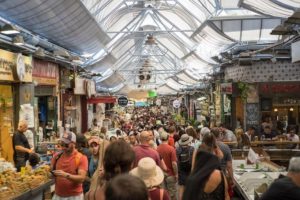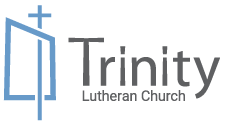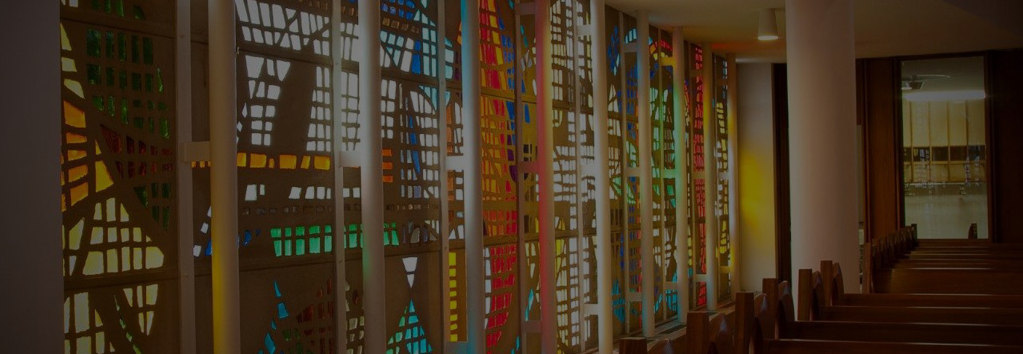The architecture of holiness in the “great cathedral of the Sabbath”
Beloved community,
 Two years ago, my interfaith sojourners and I spent Friday in preparation for the Sabbath with the bustling populace of Jerusalem. A highlight of that day was a couple of hours in the Machaneh Yehuda market, shoulder to shoulder with the people of Jerusalem completing their shopping for the Sabbath meals which would begin in a few hours’ time. Stalls loaded with vegetables, spices, breads, meats and many other goods were stacked high for the throngs of shoppers completing their Sabbath preparation, the concluding acts of the work week, and the energy in that maze of vendors peddling their products with great vigor was infectious. It was a privilege to have that time away from the sacred sites to be among the Jerusalem community in its weekly rhythm of life.
Two years ago, my interfaith sojourners and I spent Friday in preparation for the Sabbath with the bustling populace of Jerusalem. A highlight of that day was a couple of hours in the Machaneh Yehuda market, shoulder to shoulder with the people of Jerusalem completing their shopping for the Sabbath meals which would begin in a few hours’ time. Stalls loaded with vegetables, spices, breads, meats and many other goods were stacked high for the throngs of shoppers completing their Sabbath preparation, the concluding acts of the work week, and the energy in that maze of vendors peddling their products with great vigor was infectious. It was a privilege to have that time away from the sacred sites to be among the Jerusalem community in its weekly rhythm of life.
As sunset approached everything changed. The streets were silent, the stalls shuttered, and the community began to gather for Friday sabbath services. We joined with a local Reformed Jewish congregation for worship and then received the goodness of their hospitality for a meal at the synagogue, again shoulder to shoulder with the people of Jerusalem. As we left the synagogue that evening, we noted that many of the congregation’s members simply walked home, forgoing their vehicles for the Sabbath day which had begun at sunset. At our hotel, the elevators were programmed to stop on every floor, so that guests would not have to select a floor, which was apparently considered work from which to abstain on the Sabbath.
The intentionality of the time set apart each week for worship and family is what Abraham Joshua Heschel called “the great cathedral of the Sabbath.” The ritual living of the Jewish community as it marked that weekly time set apart was vivid in the Jerusalem community, in which time itself became the architecture of holiness. I treasured such reverence to Sabbath observance, and careful adherence to Sabbath ordinances that clearly set apart time as a gift of the Creator, and a gift to be treasured.
The way in which we set apart and measure time has become a quiet undercurrent in the nearly five months of our 2020 pandemic retreat in this country. For many, there is still adherence to the “safer at home” directive of our state’s Phase 4 re-entry plan, the recognition that if we can work from home and keep distinctive physical distancing as our day-to-day reality, we will hopefully emerge from this quarantine a healthier community. For all of us, that has meant a change in the way we live, without the usual trips to restaurants and retail venues, to school athletic events and concerts, to festivals and live gatherings in parks, stadiums or auditoriums. Though much of our society has resumed activity, we have more time on our hands, even if we feel exhausted at day’s end. Coronavirus fatigue is setting in, but we are aware of a different way of marking time, and perhaps a less frenetic passing of time . . .
To some degree, we have all been assigned an unwelcome ‘sabbath,’ especially as it has to do with the way we have been quarantined. For those who are finding themselves homebound and struggling due to COVID-19 vulnerability or economic crisis, this ‘sabbath’ leave of absence is deeply challenging. But we can seek to gradually transform this new day and enter into something holy, something welcome, as we traverse this deep societal pause.
Rebecca and I are eating together more frequently at table, cooking nearly all our meals, and lighting candles while we dine, even at breakfast. We have more time for gardening, conversing and planning when I am working out of my home office, and that has been lifegiving. A good walk, good reading and good rest have all become somewhat normalized in this time of upheaval and, on some levels, the “COVID Sabbath retreat” of these months has had positive outcomes. A discipline of weekly Zoom conversations with our three sons and daughter-in-law will likely continue in our post-pandemic lives. My prayer life is less compartmentalized, and our dog Kalli has never been happier with the circumstance of her people at home. We are certainly still busy, but time set apart from our ‘old normal’ has invited our creative ‘sabbath making.’
‘Sabbath’ draws on the Hebrew word ‘Shabbat.’ Shabbat is translated ‘rest’ or ‘a cessation of activity.’ The seventh day of creation is intended to be a gift of God, a Sabbath mystery in which time itself is transformed and perceived as holy. Setting apart the Sabbath is an act of faith, an act of stepping away from the six days of our focus on the acquisition of space to the one day in which we receive the gift of time, from our workday world and the accumulation of goods to the day in which we pause in prayer and praise of the Creator of all.
Friends in Christ, I hope that you grasp and receive some of the positive aspects of this enforced sabbath, that you might redeem some of your pandemic fatigue with an architecture of holiness, a setting apart of time for the goodness of residing in the great cathedral of the Sabbath. I pray that you will perceive some of the privilege of this time.
Blessings to you, O people of Trinity. May you be safe, may you be well, and may you be held in love.
It remains a privilege to serve as one of your pastors.
Grace and peace,
Pastor Robert Linstrom
1 Buechner, Frederick, Wishful Thinking; A Theological ABC (New York: Harper and Row, 1973), pages 33-34.


